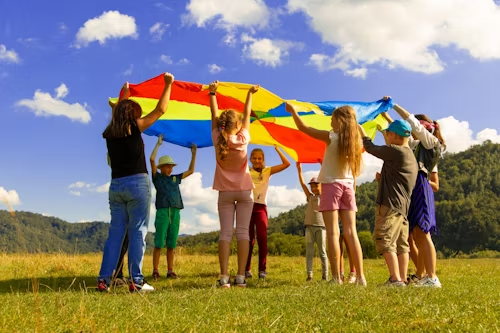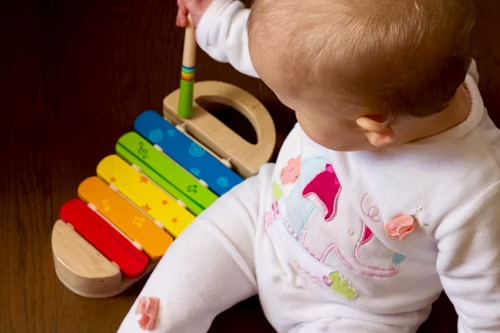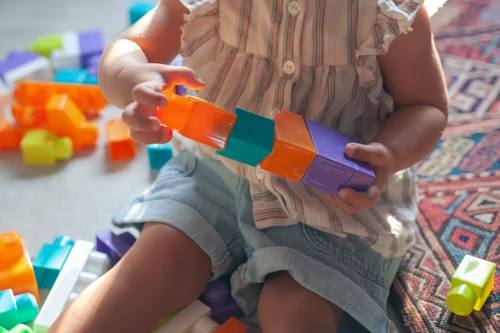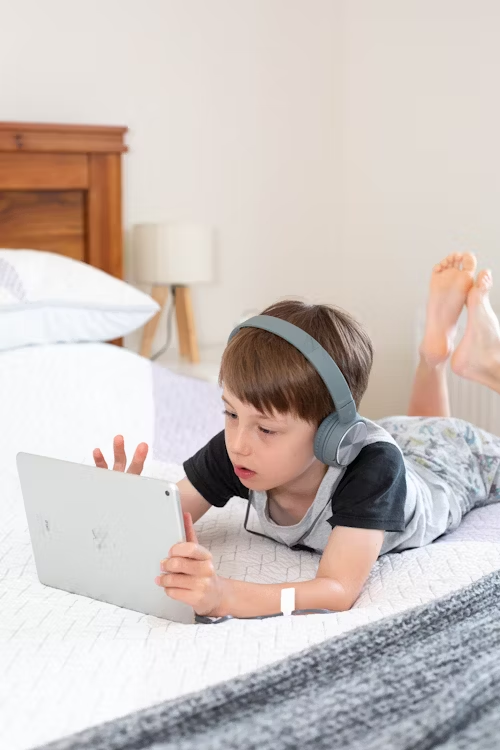
Toys for young children should align with their developmental stages and emerging skills. Many safe and suitable play materials are everyday household items. Cardboard boxes, plastic bowls, lids, plastic bottle caps collections, and other “treasures” can be used creatively by children of various ages. As you review the lists of recommended toys for different age groups, remember that each child develops at their own pace. Toys from any list—if they are safe—can be excellent choices for children younger and older than the suggested age range.
Age-Appropriate Toy Tips: Excellent Choices for All 2024!
Young Infants’ Toys (0 to 6 Months):
Babies, in their early stages of development, exhibit a profound fascination with the world around them. They delight in observing people, eagerly tracking movements with their eyes, and displaying a preference for faces and vibrant colors that captivate their attention. With burgeoning curiosity, they eagerly reach out to grasp objects within reach, reveling in discovering their hands and feet newfound abilities. As they navigate their physical environment, they exhibit growing motor skills, from the remarkable feat of lifting their heads to the attentive turning toward sounds that intrigue them. They eagerly engage their senses in their exploratory journey, mouthing and manipulating objects to glean tactile sensations and sensory feedback, enriching their burgeoning understanding of the world.
In this pivotal period of early development, babies begin a journey of sensory exploration and discovery, each experience contributing to their evolving cognitive and physical abilities. Their innate curiosity drives them to engage with their surroundings actively, prompting them to investigate the world with wide-eyed wonder and enthusiasm. Through these exploratory endeavors, they refine their motor skills and lay the foundation for cognitive growth and sensory awareness. Every interaction, from reaching out to touch an object to turning towards a new sound, represents a significant milestone in their developmental journey. It highlights the importance of offering a nurturing environment with stimulating stimuli that foster their innate curiosity and facilitate their holistic development.
Young Infants’ Toys:
- Interactive Objects: Rattles, large rings, squeeze toys, teething toys, soft dolls, textured balls, and vinyl or board books—items they can reach for, hold, suck on, shake, and make noise with.
- Auditory Stimuli: Books with nursery rhymes, poems, and recordings of lullabies and simple songs.
- Visual Stimuli: Pictures of faces hung where the baby can see them and unbreakable mirrors.
Older Infants’ Toys (7 to 12 Months)
As older babies transition into the stage of active exploration, they embark on a journey of physical discovery marked by significant milestones. From the initial stages of rolling over and sitting independently, they steadily progress to more dynamic forms of locomotion, such as scooting, bouncing, and creeping. With each newfound capability, they eagerly navigate their surroundings, driven by an insatiable curiosity to engage with the world around them.
As they develop greater strength and coordination, they demonstrate a remarkable ability to pull themselves up to standing positions, heralding the onset of newfound independence and mobility. Older babies refine their motor skills through these physical endeavors and cultivate a sense of spatial awareness and physical confidence, laying the groundwork for further exploration and discovery.
In tandem with their physical development, older babies exhibit burgeoning cognitive abilities and language acquisition skills. They demonstrate an increasing awareness of their surroundings, identifying familiar faces and reacting to their names with growing clarity. Their vocabulary expands daily, enabling them to comprehend and respond to common words and phrases. Moreover, their cognitive prowess is evidenced by their ability to identify body parts, locate hidden objects, and engage in simple problem-solving tasks. Whether it’s the joyous act of putting objects in and taking them out of containers or the thrill of uncovering hidden treasures, older babies eagerly immerse themselves in activities that stimulate their growing intellect and foster their innate curiosity about the world.
Older Infants’ Toys:
- Pretend Play Items: Baby dolls, puppets, plastic and wooden vehicles with wheels, and water toys.
- Drop and Retrieve: Plastic bowls, oversized beads, balls, and nesting toys.
- Building Toys: Large soft blocks and wooden cubes.
- Gross Motor Activities: Large balls, push-and-pull toys, and low, soft obstacles to crawl over.

1-Year-Olds’ Toys:
Children are in a perpetual state of motion at the age of one, eagerly exploring the world around them with newfound mobility. Walking steadily and mastering the art of climbing stairs, they revel in their growing independence and physical capabilities. Despite their boundless energy, they also display a budding interest in language and social interaction, delighting in the auditory delights of storytelling and the beginnings of verbal expression.
While they may engage in parallel play alongside other children, their interactions are primarily observational, as they have yet to grasp the concept of collaborative playfully. Nevertheless, their innate curiosity propels them to embark on exploratory adventures, making each moment an opportunity for discovery and learning, albeit under the watchful eye of attentive adults who safeguard their well-being.
As one-year-olds navigate their environment zealously, their insatiable curiosity drives them to explore and experiment, eager to unlock the world’s mysteries. From investigating new textures to testing their physical boundaries, they embrace each moment as an opportunity for discovery and growth. However, amidst their boundless exploration, they still rely on the guidance and protection of adults to ensure their safety. While their newfound independence is cause for celebration, it is tempered by the need for vigilant supervision as they navigate their expanding world’s exhilarating yet potentially hazardous terrain. With the support of caring adults, one-year-olds are free to embrace the wonders of exploration, laying the foundation for a lifetime of curiosity and discovery.
1-Year-Olds’ Toys:
- Books: Board books with simple illustrations or photos of natural objects.
- Audio Materials: Recordings with songs, rhymes, simple stories, and accompanying pictures.
- Creative Supplies: Wide, nontoxic, washable markers, crayons, and large paper.
- Pretend Play Items: Toy phones, dolls and doll beds, baby carriages and strollers, dress-up accessories (scarves, purses), puppets, stuffed toys, plastic animals, and realistic plastic and wooden vehicles.
- Construction Toys: Cardboard and wooden blocks (smaller than those for infants—2 to 4 inches).
- Muscle-Engaging Toys: Puzzles, large pegboards, toys with interactive parts (dials, switches, knobs, lids), and large and small balls.
2-Year-Olds’ Toys (Toddlers):
As toddlers rapidly acquire language skills and begin to grasp the concept of danger, they embark on intense exploration and experimentation. Despite their growing awareness of potential hazards, they eagerly engage in physical “testing,” pushing the boundaries of their capabilities through activities like jumping from heights, climbing, and indulging in rough-and-tumble play. Their innate curiosity propels them to enthusiastically explore the world around them, even as they navigate the newfound complexities of language and safety. While they may encounter bumps and bruises along the way, each experience is a valuable learning opportunity, fostering their physical development and expanding their understanding of their surroundings.
In tandem with their physical exploration, toddlers exhibit impressive dexterity and fine motor skills, demonstrating a keen ability to manipulate small objects precisely. With reasonable control of their hands and fingers, they revel in the sensory experience of touching, grasping, and manipulating various items. Whether stacking blocks, sorting toys, or engaging in imaginative play, they eagerly immerse themselves in activities that stimulate their tactile senses and foster their burgeoning creativity. Despite the occasional mishap, their adventurous spirit remains undeterred as they continue to navigate the exhilarating journey of toddlerhood with boundless enthusiasm and curiosity.
2-Year-Olds’ Toys:
- Problem-Solving Toys: Wooden puzzles (4 to 12 pieces), snap-together blocks, sorting objects (by size, shape, color, smell), and items with hooks, buttons, buckles, and snaps.
- Pretend Play and Building: Blocks, sturdy transportation toys, construction sets, child-sized furniture (kitchen sets, chairs, play food), dress-up clothes, dolls with accessories, puppets, and sand and water play toys.
- Creative Supplies: Large, nontoxic, washable crayons and markers, large paintbrushes and finger paint, large paper for drawing and painting, colored construction paper, toddler-sized scissors with blunt tips, chalkboard and large chalk, and rhythm instruments.
- Books and Media: Picture books with more details than those for younger children, and CD/DVD players with various music (phonograph players and cassette recorders work, too!).
- Muscle-Engaging Toys: Large and small balls for kicking and throwing, ride-on equipment (likely not tricycles until age 3), tunnels, low climbers with soft material underneath, and pounding and hammering toys.

Preschoolers and Kindergarteners’ Toys (Ages 3-6):
Preschoolers and kindergarteners enjoy extended attention spans compared to toddlers, allowing them to immerse themselves more deeply in activities and inquiries. Often talkative, they eagerly ask questions and experiment with objects and physical abilities, fostering a robust curiosity about their surroundings. While they relish playing with friends, they may encounter challenges with losing during games. However, they steadily develop skills in turn-taking and sharing, fostering essential social competencies.
Navigating play dynamics, preschoolers and kindergarteners cultivate cooperation and collaboration skills. They grasp the concept of taking turns and readily sharing toys among peers, fostering empathy and mutual respect. Through these interactions, they develop vital social and emotional competencies, setting the stage for healthy relationships and effective communication in various contexts.
3- to 6-Year-Olds’ Toys:
- Problem-Solving Toys: Puzzles (12 to 20+ pieces), snap-together blocks, and collections of smaller objects for sorting by various attributes like length, width, height, shape, color, smell, and quantity (e.g., plastic bottle caps, keys, shells, counting bears, small colored blocks).
- Pretend Play and Building: Multiple blocks for constructing intricate structures, transportation toys, construction sets, child-sized furniture (e.g., “apartment” sets, play food), dress-up clothes, dolls with accessories, puppets and simple puppet theaters, and sand and water play toys.
- Creative Supplies: Large and small crayons and markers, paintbrushes and finger paint, various sizes of paper for drawing and painting, colored construction paper, preschooler-sized scissors, chalkboard, and chalk, modeling clay and playdough, modeling tools, paste, and materials for collage (e.g., paper and cloth scraps). Additionally, rhythm instruments, keyboards, xylophones, maracas, and tambourines are used.
- Books and Media: Picture books with more words and detailed pictures than toddler books and CD/DVD players featuring various music (traditional phonograph players and cassette recorders are also suitable).
- Muscle-Engaging Toys: Large and small balls for kicking and throwing/catching, ride-on equipment including tricycles, tunnels, taller climbers with soft material underneath, wagons and wheelbarrows, plastic bats and balls, plastic bowling pins, targets, and projectiles, and a workbench with tools such as a vise, hammer, nails, and saw.
- Computer Access: Interactive programs with graphical and spoken instructions, allowing children to control the pace and path of their exploration while delving into various concepts on multiple levels.
Children and Toy Safety
Safety is crucial when choosing toys for young children. Ideal toys are well-crafted, devoid of sharp edges or splinters, and free from pinch hazards. They should also be painted with nontoxic, lead-free paint, shatter-proof, and easy to clean. Additionally, electric toys should bear the “UL Approved” label, signifying approval by the Underwriters Laboratories, ensuring they meet safety standards. It’s crucial to avoid toys with small parts or pieces that could cause choking hazards, particularly for children under three years old.
Vigilance is vital to maintaining toy safety. Adults should routinely inspect toys for signs of wear and tear, as even seemingly safe toys can become hazardous over time. Regular checks ensure that toys remain in good condition and continue to provide safe play experiences for children.
Conclusion:
Toys designed for young children should match their developmental stages and growing abilities. When toys are chosen to match children’s unique phases of growth and emerging skills, caregivers can offer valuable experiences that enhance their learning and exploration. These toys stimulate children’s curiosity and creativity while promoting the development of vital cognitive, physical, and social skills. Ultimately, selecting toys corresponding to children’s developmental stages nurtures comprehensive growth and establishes a sturdy groundwork for their ongoing learning endeavors.





